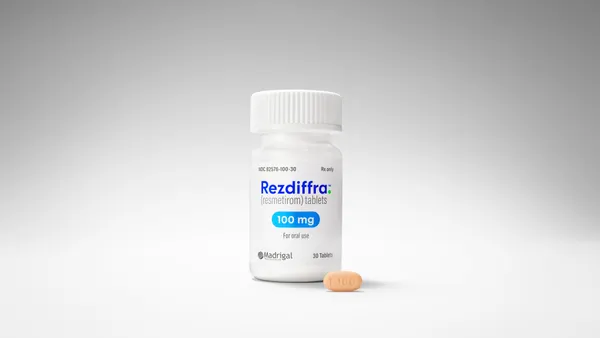8 J u l y 2 00 3 PharmaVOICE E M For the first time, individual companies must establish their own identity with consumers. Executives should focus on identifying their company’s most unique and positive characteristics and communicate them in a single, simple message that can be translated for each portion of the business and each audience. MICHAELKEMPNER MASTER BRAND BY KIM RIBBINK BUILDING A POWERFUL CORPORATE IDENTITY Most pharmaceutical companies concentrate their branding efforts on building identities for their marketed products and, in some cases, on a therapeutic category as way to improve disease awareness. But as the number of products com ing from less fruitful pipelines become fewer, negative media reports continue to beset the industry, and the weak economy takes its toll, companies will need to present a more unified corporate identity, according to industry experts. A corporate brand, or master brand, can resonate with all of the stakeholders in a company — from employees and prospective employees, to customers, to the financial community, and the media. A strong corporate identify can help a company ride out bad times and give the entity even greater credibility in good times. A strong corporate brand can even contribute significant ly to a company’s market capitalization, accord ing to data (see page 18 for more information). But before launching into a corporate branding campaign, executives need to under stand what the company stands for, what they hope to convey, and how their staff and cus tomers view the corporation. Above all, the company must create an identity that it can live up to, so that the corporate brand can help leverage marketed pharmaceutical brands, and the brand, in turn, can leverage the company. ESTABLISHINGTHE BRAND DETTORE. One way companies can commu nicate and build brand awareness and brand equity is to consolidate funds and support branding strategies from a master brand per spective. Through DTC advertising, compa nies are trying to put forward the corporate identity in the customer’s mind — to the pro fessional as well as the end consumer. With tough economic times and shrinking pipelines, advertising dollars are being reduced. With that in mind, companies can promote multiple products and then use the limited dollars in a much more impactful and costefficient manner by leveraging the trust that is imparted from the corporate master brand. This trend is increasing as more com panies are rethinking the overall packaging and marketing of their products. Companies can now start to get more “bang for the buck” PHOTO BYTODD PLITT, IMAGEBOX PHOTOGRAPHY 9 PharmaVOICE J u l y 20 03 CORPORATE branding brand is developing a strong product brand. For example, Pfizer has been quite successful in building its corporate identity through its marketing of Viagra. But, most consumers would not be able to identify ScheringPlough as the manufacturer of Claritin. NORTON.There are a number of compelling reasons for pharma companies to build and maintain a strong brand identity, not least of which is to defend the equity that they cur rently have. There are studies that show that a company’s stock price is directly related to brand identity. From that aspect alone, it’s smart to establish a corporate brand. In the 1980s, Pfizer didn’t have a very good pipeline. While the company invested in research it also was one of the first companies to invest in a IDENTITY ARCHITECTS JEFFREY ARONIN.President and founder, Ovation Pharmaceuticals,Deerfield, Ill.; Ovation is a specialty pharmaceutical company that acquires underpromoted branded pharmaceutical products and promising latestage development products.For more information, visit ovationpharma.com. MARTHABOWMAN. Executive VP, marketing, DeLor,Louisville,Ky.; Delor is a brand identity consulting company that uses the power of brand identity to build strong brands for pharmaceutical corporations, therapeutic franchises, and products. For more information, visit delorgroup.com. MARIACASINI.VP,creative director, Accel Healthcare Communications LLC, NewYork; Accel Healthcare is a fullservice healthcare advertising agency. For more information,visit accelhealth.com. CAROLYNCASTEL.Executive director, corporate communications,Serono Inc., Rockland,Mass.; Serono is a global biotechnology company with products available in three therapeutic areas: reproductive health,neurology,and growth and metabolism.For more information,visit seronousa.com. JAMES L.DETTORE.President and CEO,Brand Institute Inc., Miami; Brand Institute is a full service brand identity consultancy dedicated to the strategic and innovative development of nomenclature and identity solutions in the pharmaceutical,biotechnology,and medical device industries. For more information,visit brandinstitute.com. JAY DONIGER.VP,group creative head — advertising,Donahoe Purohit Miller, Chicago; DPM is a fullservice healthcare advertising agency providing clients with comprehensive marketing and communications strategic planning,market research and analysis, and integrated medical education capabilities. For more information, visit dpmadvert.com. THOMAS EBELING.CEO,Novartis Pharma AG,Basel, Switzerland; Novartis,with U.S. headquarters in New York, is a leading pharmaceutical company with core businesses in pharmaceuticals, consumer health, generics,eye care, and animal health.For more information, visit novartis.com. JAMES R. GREGORY. CEO, CoreBrand,Stamford, Conn.;CoreBrand helps companies understand,craft, measure, and leverage the essence of their corporate brands. For more information, visit corebrand.com. TOM GRINNAN.VP,business development,Mead Westvaco Healthcare Packaging Group (HP), Stamford,Conn.; MeadWestvaco is a global producer of packaging, coated and specialty papers,consumer and office products,and specialty chemicals.For more information,visit meadwestvaco.com. GREGORYB.HOLMES,PH.D.Executive VP,clinical operations,SFBC International,Miami; SFBC conducts and manages clinicaltrial services in most therapeutic areas, for major pharmaceutical companies,CROs, and biotechnology companies. For more information, visit sfbci.com. MICHAELW.KEMPNER. President and CEO,The MWWGroup,East Rutherford,N.J.; MWW Group is a public relations and marketing communications firm. For more information, visit mwwpr.com. SARI MACRIE. Senior VP, corporate communications, Cardinal Health Inc., Dublin,Ohio; Cardinal Health companies develop,manufacture, package,and market products for patient care;develop drug delivery technologies;distribute pharmaceuticals, medical surgery and laboratory supplies; and offer consulting and other services that improve quality and efficiency in healthcare.For more information, visit cardinal.com. GUYMASTRION.ExecutiveVP and managing director, creative, Palio Communications,Saratoga Springs, N.Y.; Palio is a fullservice, strategically driven advertising and communications company. For more information, visit paliocommunications.com. KATHLEENM.MILLIGAN.VP,marketing and sales, Endeavor Pharmaceuticals Inc.,Wilmington,N.C.; Endeavor Pharmaceuticals is a specialty pharmaceutical company focused on improving women’s health by developing and marketing advanced hormone therapies with competitive advantages over existing therapies. For more information,visit endeavorpharm.com. KURT MUSSINA.VP, international business development, Inveresk,Cary, N.C.;Inveresk provides drugdevelopment services to companies in the pharmaceutical and biotechnology industries, including preclinical safety and pharmacology evaluation services, laboratory sciences services, and clinical development services. For more information, visit inveresk.com. MICHAEL NORTON.Chief strategy officer, Euro RSCG Life Worldwide, and president,Euro RSCG Life Brand Machine, New York; Euro RSCG Life Worldwide is a health communications company.For more information,visit eurorscglife.com. VERNOAKLEY.Founder and creative director, Tribe Pictures, Chatham,N.J.;Tribe Pictures delivers complex business messages clearly, effectively, and creatively, using the power of moving pictures. For more information,visit tribepictures.com. KENRIBOTSKY.President,Ribotsky Worldwide Inc., Somerset,N.J.; Ribotsky is a fullservice healthcare communications agency providing marketing strategies as well as advertising, promotion programs, medical education,and public relations. For more information visit ribotsky.com. RICOVIRAY.Partner,The Cementworks LLC, NewYork;Cementworks is a fullservice healthcare advertising agency.For more information, visit thecementworks.com. MAXIMH.WALDBAUM. Partner and chair of the intellectual property group,Salans, New York; Salans is a multinational law firm.For more information visit salans.com. by extending more product lines, core brands through line extensions, service offerings that support the brands and their extensions, or even new products within a therapeutic area. WALDBAUM. Without a corporate brand, companies will not be able to compete in the future. For some pharmaceutical companies, the key to developing a successful corporate 10 J u l y 2 00 3 PharmaVOICE T CORPORATE branding ARONIN. For small to midsize companies, having a strong corporate image from a very early stage is extremely important for recruiting and hiring, building infrastructure, and even raising money. Ovation was successful in secur ing financing last year, and a lot of that had to do with the company’s brand and image because that helped the financial community under stand what set Ovation apart. A strong corporate brand also is important when dealing with other companies on a variety of issues, including prod corporate image, with corporate image adver tising. One has to wonder if that helped Pfiz er garner comarketing rights to products such as Lipitor, Celebrex, and Zyrtec. DONIGER. An essential building block for even considering a corporate branding program is a stable of effective products that have them selves been successfully branded in the market place. If the objectives of a corporatebranding program are to be respected, admired, and trusted, and as a result build loyalty and attract investment, having successful marketproven products are the keys to success. GRINNAN. Most pharmaceutical and health care companies are under the clear understand ing that they are no longer just competing bio chemically or pharmacokinetically with other companies, and they are often competing with new products that have only incremental bene fits over existing compounds. In addition, they have broadened their marketing focus to include the patient, not just the physician. This shift in strategy is being reflected in what they’re doing with their corporate branding. Companies are beginning to focus on providing messages that convey better health for the con sumer in general, rather than trying to focus on the biochemical science behind the drug or the fact that they have worldclass scientists on staff. They are trying to show the patients that they understand them and are working on their behalf. Pharma companies have, in some ways, changed their brand images from chemical and biochemical giants to large, sensitive companies that are focused on patient care and health. TAKING BRAND NEW STEPS EBELING. For a company, espe cially after a merger, it is impor tant to establish a strong brand name. And frankly, we are not yet such an American household name as Pfizer and Merck so it’s important that customers quick ly identify Novartis and associ ate positive attributes to the name. That’s especially true for a newly formed company; it’s important to do a bit more and it takes time to build trust. Companies have to earn the customer’s trust. They have to make sure that they are credible and that their activities with patients and physicians meet and substantiate their claims. We believe there is a strong synergy between the creation of strong individual product brands, such as Diovan or Gleevec or Zelnorm, and a strong corporation name, like Novartis. To build a strong corporate brand we create campaigns that build on the images of our individual brands. Our main objective is to show that as a company, we understand patients, their needs, and that through innova tion we address those needs. We see Novartis as the origin brand, which we have defined through a print and radio campaign “Think What’s Possible.” That campaign, in turn, is based upon the capabilities of the individual brands, and then we link those individual brands back to the theme of Novartis. Potential pitfalls to a branding effort include under funding the campaign, vague objectives, inadequate account planning and research to track progress, shortsightedness, and lack of internal support. Many corporatebranding campaigns are misunderstood and filled with selfserving copy. RICOVIRAY It would be interesting for pharmaceutical companies to consider a more integrated brand architecture when they’re looking at corporate branding. MARTHABOWMAN 12 J u l y 2 00 3 PharmaVOICE CORPORATE branding panies must establish their own identities with consumers. Marketing and communications executives should focus on identifying their company’s most unique and positive character istics and communicate them in a single, sim ple message that can be translated for each por tion of the business and to each audience. MUSSINA. Successful brands are built on a clear, honest understanding of a company’s unique capabilities. We talked with employees, clients, key opinion leaders in the industry, and we analyzed the industry to gain insight into how to accurately and clearly communicate Inveresk’s values and unique strengths to meet the needs of customers. The process helped us target and validate Inveresk’s core brand. CASTEL.In our early years, Serono was defined by a single product, which was Pergonal, a fer tility drug. The company began to grow and expand into different therapeutic areas, such as growth hormone therapies for pediatric growth disorders and for AIDS wasting, and also, more recently, into neurology. The company’s prod uct portfolio was expanding, which meant equating Serono to a single brand was no longer an appropriate image. We needed to evaluate how the company as a whole could begin to uct acquisitions. The hardest thing for specialty pharma companies to do today is to differentiate themselves to big pharma. Our marketing and sales teams spend considerable time educating stakeholders, not just about Ovation’s product portfolio, but also about the company’s business model, its therapeutic focus, and its potential as a longterm partner. MILLIGAN.The starting point for our corporate identity was a set of two workshops, one with the entire senior management team and another with all other employees. Before each workshop, we put out a questionnaire asking each partici pant howheor she viewed the company in terms of its mission and culture. We even included some basic questions as to who our customers are and what market we address. We also did research into how other companies, including competitors and corporations outside pharma, brand themselves. That gave us a sense of how other companies position themselves and how credible that positioning is. Talking about these Some people tend to think that a corporate brand is just a logo or advertising,when it’s really about everything the company says and does on an ongoing basis. JAMES GREGORY Some of the value of building a corporate brand is that it helps us keep focused, which for a small company is essential. KATHLEEN MILLIGAN A common thread that ties a company’s products together gives customers a reason to believe that the company’s offerings are valid and good and have value. KENRIBOTSKY issues was a wonderful chance to express who we think we are, what we stand for, what wewant to become, and what the gaps are between how we would like Endeavor to be and how it is today. ARONIN. Our message and our image have stayed fundamentally the same, but they have evolved to include the customer and where the company is in its lifecycle. The mission and the message were established from the beginning, w th the help of input from many people who understand the state of the pharmaceutical industry and the needs of the marketplace. KEMPNER.For the first time, individual com 14 J u l y 20 03 PharmaVOICE CORPORATE branding leverage its brands and how the brands could leverage the company. On another front, Serono had pro duced its products by extracting human proteins from different sub stances. The company then produced the very first recombinant versions of its drugs — fertility drugs and growth hormone — and was trans formed into a biotechnology compa ny. Webuilt the corporate brand first by using our original products. As we widened our product base into other therapeutic areas we defined our new corporate image. Now, the corporate brand supports those prod uct brands, and vice versa. HOLMES.In2002, we acquired two leading companies each with their own brand identity, which chal lenged us to position SFBC as one of the global providers of clinical services in the industry. It was clear after the rapid integration of these two companies that a strong corporate brand needed to be developed so that SFBC could position itself as a unified organization with a single message to enable it to sell a broad er range of services under one strong brand. MACRIE. Since our founding 30 years ago, Cardinal Health has delivered strong internal growth, as well as growth through acquisi tions — having acquired more than 40 com panies since 1980. The company is organized around two key markets — healthcare prod ucts and services and lifesciences products and services. But, despite leadership positions in those markets, many people, even our own customers, did not understand all of the things that we did, nor were they aware of all the capabilities we have. We recognized the opportunity to deepen our customer relation ships, improve employee recruitment and The global consolidation within the healthcare industry has allowed corporate brands to become a greater force when introducing individual products to the marketplace. JAMES DETTORE Our corporate brand campaign shows that we truly aim to understand the needs of patients and that we truly try to help them. The patient is what it’s all about. THOMAS EBELING There are some within the pharmaceutical industry who still think that corporate branding is not worth the investment. However, savvy brand managers are seeking ways to extend the life of their products by strengthening their corporate and product brands. MAXIMWALDBAUM 16 J u l y 2 00 3 PharmaVOICE CORPORATE branding retention, and investor understanding if these key constituencies had better awareness of the breadth of our services. Once we determined the benefit, we developed our branding strate gy. We started, as most good programs start, from the inside out. We looked at our own capabilities, our vision, our mission, where we wanted to go. Then we went outside to research what our customers and other key stakeholders were looking for and looked internally to deter mine what our employees were looking for. We also scanned the competitive environment, tried to understand where we would fit from a positioning perspective, and where we would have the greatest success. We used all of that information to build our brand platform, which is organized around two key concepts: our brand promise, which is about delivering part nership, innovation, and integration; and our brand personality, which is about being real, robust, and relentless. Those two concepts together form the foundation for Cardinal Health going to market as one company. HOLMES. In collaboration with a marketing agency, we first administered a questionnaire to key individuals within SFBC’s divisions to gather strategic information to identify our “corporate personality.” We were interested in obtaining information about the points of dif ferentiation from the competition; core values for the company; the essence of the brand; and characterizing the overall image through a specifically designed process. This important process helped us define SFBC. From the begin ning, the goal was to promote the overall ser vices offered by SFBC International instead of the various subsidiaries within SFBC. By doing so, we are able to project SFBC as one unified organization offering a full spectrum of services through its various subsidiaries. The new logo was then created from that process to reflect the “human touch,” which is so important to the organization. CASTEL. The approval of our prod uct Rebif for multiple sclerosis in the United States and the path that brought Rebif to the U.S. market was a defining moment for the company. There was a product on the market that had an orphandrug indication, and by means of a headtohead study we were able to prove clinical superi ority and overcome the orphan drug exclusivity and bring Rebif to mar ket. That brought forward a better product for patients and spoke vol umes about the tenacity of the
An article from










